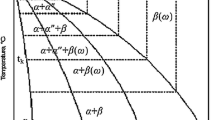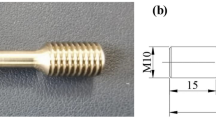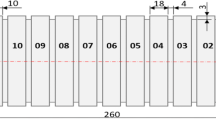Abstract
Anti-fatigue performance is vital for components used in aerospace industry, and cutting processes were widely considered to modify the workpiece anti-fatigue performance. However, most of the existing researches only associated the anti-fatigue performance to the cutting condition and surface integrity, without revealing the effect of material microstructure. In this work, the Incoloy A286 and titanium alloy TC17, two kinds of commonly used material in aerospace industry, were adopted as samples to reveal the influence mechanism of material microstructure on the high-speed cutting modified anti-fatigue performance. It was found that, due to the different microstructure, especially the grain structure and size, the effects of cutting process on the machined surface integrity and anti-fatigue performance of these two materials were different. For Incoloy A286, the large size and cubic structure increased the difficulty in deformation and breaking of grains, making the cutting parameters have limited effect on grain refinement. Hence, the fracture toughness of machined surfaces decreased on the whole with an increased feed rate and depth of cut, which reduced the fatigue life. For titanium alloy TC17, the small lath-shaped grains were easy to deform and break, resulting in the notably grain refinement of machined surfaces, which contributed to the prolonged fatigue life when the feed rate and depth of cut increased. All in all, the material microstructure may change the effect rule of cutting process on the machined workpiece anti-fatigue performance, and thus the cutting condition should be designed by considering the material microstructure.
















Similar content being viewed by others
Data availability
The raw data required to reproduce these findings cannot be shared at this time as the data also forms part of an ongoing study. The processed data required to reproduce these findings are available to download from https://doi.org/10.17632/yhwc79vrfz.2.
References
Novovic D, Aspinwall DK, Dewes RC, Bowen P, Griffiths B (2016) The effect of surface and subsurface condition on the fatigue life of Ti–25V–15Cr–2Al–0.2 C% wt alloy. CIRP Ann 65(1):523–528
Novovic D, Dewes RC, Aspinwall DK, Voice W, Bowen P (2004) The effect of machined topography and integrity on fatigue life. Int J Mach Tools Manuf 44(2-3):125–134
Umbrello D, Rotella G (2018) Fatigue life of machined Ti6Al4V alloy under different cooling conditions. CIRP Ann 67(1):99–102
Liu G, Huang C, Zhu H, Liu Z, Liu Y, Li C (2017) The modified surface properties and fatigue life of Incoloy A286 face-milled at different cutting parameters. Mater Sci Eng A 704:1–9
Liu G, Özel T, Li J, Wang D, Sun S (2020) Optimization and fabrication of curvilinear micro-grooved cutting tools for sustainable machining based on finite element modelling of the cutting process. Int J Adv Manuf Technol 10(5):1327–1338
Gajrani KK, Suresh S, Sankar MR (2018) Environmental friendly hard machining performance of uncoated and MoS2 coated mechanical micro-textured tungsten carbide cutting tools. Tribol Int 125:141–155
Liu G, Huang C, Zou B, Wang X, Liu Z (2016) Surface integrity and fatigue performance of 17-4PH stainless steel after cutting operations. Surf Coat Technol 307:182–189
Smith S, Melkote SN, Lara-Curzio E, Watkins TR, Allard L, Riester L (2007) Effect of surface integrity of hard turned AISI 52100 steel on fatigue performance. Mater Sci Eng A 459(1-2):337–346
Guo YB, Warren AW (2008) The impact of surface integrity by hard turning vs. grinding on fatigue damage mechanisms in rolling contact. Surf Coat Technol 203(3-4):291–299
Hashimoto F, Guo YB, Warren AW (2006) Surface integrity difference between hard turned and ground surfaces and its impact on fatigue life. CIRP Ann 55(1):81–84
Xun LI, Chunming G, Peng Z (2018) Influences of milling and grinding on machined surface roughness and fatigue behavior of GH4169 superalloy workpieces. Chin J Aeronaut 31(6):1399–1405
Sharman ARC, Aspinwall DK, Dewes RC, Clifton D, Bowen P (2001) The effects of machined workpiece surface integrity on the fatigue life of γ-titanium aluminide. Int J Mach Tools Manuf 41(11):1681–1685
Ghanem F, Sidhom H, Braham C, Fitzpatrick ME (2002) Effect of near-surface residual stress and microstructure modification from machining on the fatigue endurance of a tool steel. J Mater Eng Perform 11(6):631–639
Sasahara H (2005) The effect on fatigue life of residual stress and surface hardness resulting from different cutting conditions of 0.45% C steel. Int J Mach Tools Manuf 45(2):131–136
Javidi A, Rieger U, Eichlseder W (2008) The effect of machining on the surface integrity and fatigue life. Int J Fatigue 30(10-11):2050–2055
Jeelani S, Musial M (1984) Effect of cutting speed and tool rake angle on the fatigue life of 2024-T351 aluminium alloy. Int J Fatigue 6(3):169–172
Choi Y (2017) Influence of rake angle on surface integrity and fatigue performance of machined surfaces. Int J Fatigue 94:81–88
Choi Y (2015) Influence of feed rate on surface integrity and fatigue performance of machined surfaces. Int J Fatigue 78:46–52
Suraratchai M, Limido J, Mabru C, Chieragatti R (2008) Modelling the influence of machined surface roughness on the fatigue life of aluminium alloy. Int J Fatigue 30(12):2119–2126
Yao C, Wu D, Ma L, Tan L, Zhou Z, Zhang J (2016) Surface integrity evolution and fatigue evaluation after milling mode, shot-peening and polishing mode for TB6 titanium alloy. Appl Surf Sci 387:1257–1264
Wagner L (1999) Mechanical surface treatments on titanium, aluminum and magnesium alloys. Mater Sci Eng A 263(2):210–216
Klumpp A, Maier S, Chen H, Fotouhi M, Schneider R, Dietrich S, Schulze V (2018) Influence of work-hardening on fatigue crack growth, effective threshold and crack opening behavior in the nickel-based superalloy Inconel 718. Int J Fatigue 116:257–267
Mantle AL, Aspinwall DK (1997) Surface integrity and fatigue life of turned gamma titanium aluminide. J Mater Process Technol 72(3):413–420
Liu G, Huang C, Zou B, Liu H, Liu Z, Liu Y, Li C (2020) The modification of corrosion resistance of 17-4PH stainless steel by cutting process. J Manuf Process 49:447–455
An Q, Chen J, Tao Z, Ming W, Chen M (2019) Experimental investigation on tool wear characteristics of PVD and CVD coatings during face milling of Ti 6242S and Ti-555 titanium alloys. Int J Refract Met Hard Mater 86:105091
An Q, Dang J (2020) Cooling effects of cold mist jet with transient heat transfer on high-speed cutting of titanium alloy. Int J Precis Eng Manuf Technol 7(2):271–282
Arola D, Williams CL (2002) Estimating the fatigue stress concentration factor of machined surfaces. Int J Fatigue 24(9):923–930
Saberifar S, Mashreghi AR, Mosalaeepur M, Ghasemi SS (2012) The interaction between non-metallic inclusions and surface roughness in fatigue failure and their influence on fatigue strength. Mater Des 35:720–724
Koster WP, Field M (2001) Effects of machining variables on the surface and structural metals. Proc. NORTH Am. Manuf. Res. Conf. SME
Funding
This work is financially supported by National Natural Science Foundation of China (Grant No. 52005281), Major Program of Shandong Province Natural Science Foundation (Grant No. ZR2018ZA0401), and Natural Science Foundation of Shandong Province (Grant No. ZR2020QE181 and ZR2019BEE026).
Author information
Authors and Affiliations
Contributions
LGL conducted most of the experiments and wrote the manuscript. HCZ guided the overall design and analysis of the experiments. SSF and WW helped to measure some of the surface integrity parameters. All authors read and approved the final manuscript.
Corresponding author
Ethics declarations
Conflict of interest
The authors declare that they have no conflict of interest.
Code availability
Not applicable.
Additional information
Highlights
1. Cutting process can modify workpiece surface integrity and anti-fatigue performance.
2. Material microstructure can change the effect rule of cutting process on anti-fatigue performance.
3. Effect of surface integrity on anti-fatigue performance of titanium alloy TC17 was revealed.
Publisher’s note
Springer Nature remains neutral with regard to jurisdictional claims in published maps and institutional affiliations.
Rights and permissions
About this article
Cite this article
Liu, G., Huang, C., Sun, S. et al. Effect of microstructure on high-speed cutting modified anti-fatigue performance of Incoloy A286 and titanium alloy TC17. Int J Adv Manuf Technol 113, 855–866 (2021). https://doi.org/10.1007/s00170-020-06514-0
Received:
Accepted:
Published:
Issue Date:
DOI: https://doi.org/10.1007/s00170-020-06514-0




